Figures & data
Figure 2. (a) TEM image of ∼200 nm soot particle; (b) ∼200 nm lamp wick smoke; (c) ∼154 nm soot; (d) ∼150 nm lamp wick smoke.

Figure 3. PFDMA measured mobility size of (a) size-selected ∼200 nm lamp wick smoke and (b) size-selected ∼150 nm lamp wick smoke is a constant as a function of electric field magnitude. The PFDMA was operated at sheath flow rate, Qsh = 3 L/min (0.5*10−4 m3/s), and at 100 Hz. The pulse duty cycles used to obtain different electric fields for (a) and (b) are presented in , respectively. The error bar of each data point are based on five to eight repeat voltage scans using at least two different pieces of lamp wick.
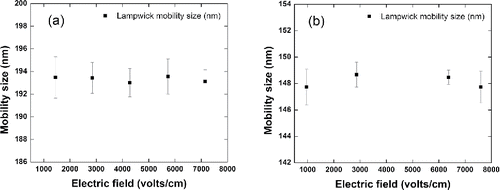
Figure 4. PFDMA measured mobility size of (a) size-selected ∼200 nm soot and (b) size-selected ∼154 nm soot, and (c) size-selected ∼129 nm soot, decreases as electric field magnitude increases due to field induced alignment. The error bars of each data point are based on three repeat voltage scans.
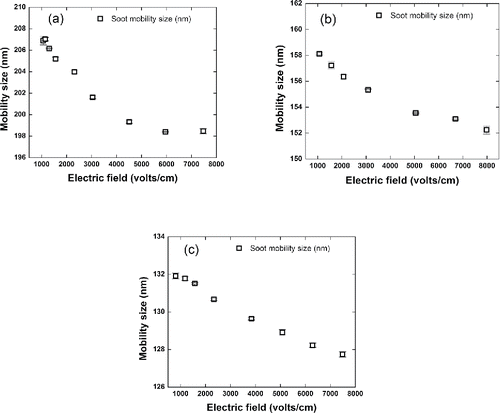
Table 1. The and
of soot calculated using the average values of the eigen-values of polarizability (α1,α2, α3) of five randomly formed soot aggregates.
and
.
Figure 5. Normalized number concentration versus mobility diameter of (a) 129 nm, (b) 154 nm, and (c) 200 nm soot for various field strengths. The data curves are raw data without 100.7 nm PSL calibrations, which may systematically affect the peak location by 1% to 2%.
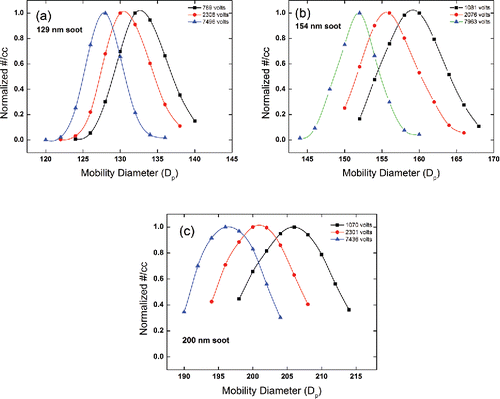
Figure 6. Full-width of mobility diameter distribution at half-peak concentration/peak diameter vs. voltage for three mobility diameters sizes.
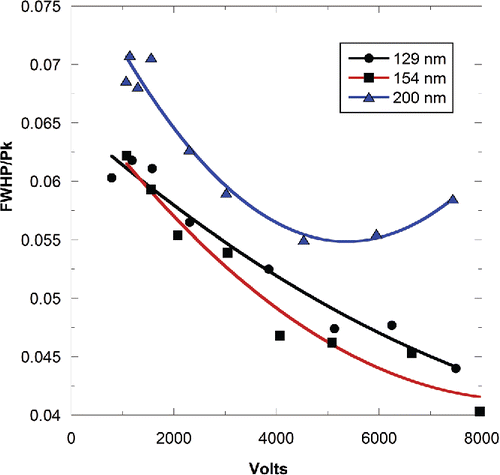
Figure 7. Experimental measured mobility for soot (black circles) (a) ∼200 nm soot, (b) ∼154 nm soot, and (c) ∼129 nm soot at various applied fields. Square dotted line (blue): modeling the soot using friction coefficient tenor of an equivalent spheroid with aspect ratio β = 1.2, and using the polarizabilities from . Triangle dotted line (purple): modeling the soot using friction coefficient tenor of an equivalent spheroid with aspect ratio β = 1.3, and using the polarizabilities from .
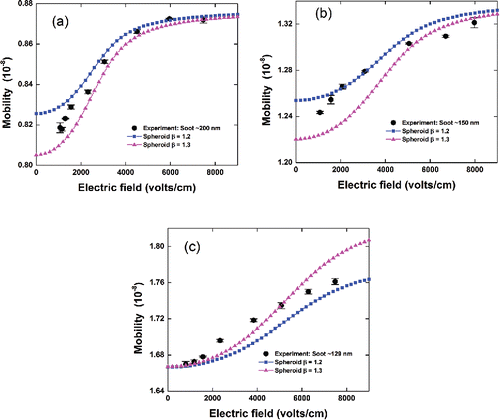
Table A1. Summary of the calibrated sheath flow rate and pulse duty cycles for PFDMA measurements to size-selected ∼200 nm lamp wick smoke at 100 Hz. Those calibrations were based on 100.7 nm NIST standard reference material (PSL sphere) measured in three repeat voltage scans under the same experimental conditions as the lamp wick smoke measurements on the same day.
Table A2. Summary of the calibrated sheath flow rate and pulse duty cycles for PFDMA measurements to size-selected ∼150 nm lamp wick smoke at 100 Hz. Those calibrations were based on 100.7 nm NIST standard reference material (PSL sphere) measured in three repeat voltage scans under the same experimental conditions as the lamp wick smoke measurements on the same day.
Table A3. Summary of the calibrated sheath flow rate and pulse duty cycles for PFDMA measurements to size-selected ∼200 nm soot at 100 Hz. Those calibrations were based on 100.7 nm NIST standard reference material (PSL sphere) measured in three repeat voltage scans under the same experimental conditions as the soot measurements on the same day.
Table A4. Summary of the calibrated sheath flow rate and pulse duty cycles for PFDMA measurements to size-selected ∼150 nm soot at 100Hz. Those calibrations were based on 100.7 nm NIST standard reference material (PSL sphere) measured in three repeat voltage scans under the same experimental conditions as the soot measurements on the same day.
Table A5. Summary of the calibrated sheath flow rate and pulse duty cycles for PFDMA measurements to size-selected ∼125 nm soot at 100 Hz. Those calibrations were based on 100.7 nm NIST standard reference material (PSL sphere) measured in three repeat voltage scans under the same experimental conditions as the soot measurements on the same day.
